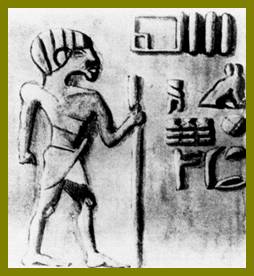
The Anu

Petrie,
1939, p. 73
![]()
I love Dr. Cheikh Anta Diop. Every
time I read the African Origins of Civilization or Great African Thinkers I get
something new out of it and it starts my mind to wondering and questioning.
Recently, I’ve turned my interests to the ancient term Anu.
Anu was called
I wondered why the nation of
Anu is also
the Sumerian [African] name for the sky or sky god. A being the first
cause [man]. The sky god whose wife was Antu in the Babylonian culture and Uras
in the Akkadian or Sumerian was also on occasion called Ki.
There symbol of authority was the ‘horned cap’ the headdress of
heroes [Heru] and gods [mighty men].
‘According to Amélineau An means man
[in Diola]. Thus Anu originally may have meant men.’ Cheikh A.Diop
Question:
Did the
concept of
“But
Here
The name Melch or
Melek means king. Zedec or Zedek means righteousness or peace.
Melchezedeck received
tithes from Abraham, the patriarch or the Hebrews according to the scriptures;
‘the lesser was bless by the greater, meaning Abraham was blessed by
Melchezedeck being the greater one.
GENESIS
14:18 Then Melchizedek king of
What does the name of
'The name of
Can
The capture of Jerusalem/Kadesh by
Thutmose III also resolves the formerly unknown source of the name
That may be a stretch for some of
you. It is difficult to see a people combing two separate words from different
languages into one, but we that all the time.
“As an adult ruler, Tuthmoses
III conducted 17 successful campaigns that served him a position as the most
successful Pharaoh ever — in military terms. He extended Egyptian territory
and power considerably, into Mesopotamia, Canaan [
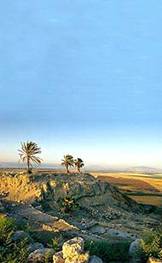
The sacredness attributed to
Please
Read carefully!
The Bible is our only source of
information about David. No ancient inscription mentions him. No archaeological
discovery can be securely linked to him. The quest for the historical David,
therefore, is primarily exegetical.”[1]
"Do we, the late-born, really
know anything at all about someone who lived in the past?"
Grete Weil, The Bride Price
Well, the point is valid. What do we know about any of it?
We must retrace the steps and look at the evidence as n any good crime.
We have to be the modern day C.S.I for history.
“The Jerusalem Jews were opposed
to the Alexandrian temple, and jealous, because they saw it as a rival temple.
When they got their version of the Septuagint, they minutely altered the
word for “Sun” (cheres) so that it read “destruction” (heres)
instead. Calling On/Anu the City of
Ok…see it? They altered the word
for Sun [cheres] so that it read destruction.
The Su was never seen as destructive but essential to the life and growth
of the earth. The Jews of Alexandria wanted to distance themselves from Anu.
The Septuagint [Greek] version speaks of On/Anu reads
“ir-ha-zedek” = “a city of righteousness”, but the altered version
read “a city of destruction”. It is because of this tiny variation between
the two versions of the Septuagint that the King James and Authorized versions
have a marginal note about the alternative reading. The correct rendering
is “city of the sun”, or “
The Strong’s and Young’s
concordance – the one every Christian stakes their life on - is in error many,
many times, this is just one incident.
If you are using a Strong's
Concordance they will try to redirect your thinking and use the word
'destruction or desolation' from the root word Aven in describing On/Anu,
but it is purely a matter of choice and blatant prejudice on their part
when defining On or Anu. They usually translate anything that has
to do with
I have found, due to the System of
White Supremacy that manifests itself as Eurocentric history and on the other
side Arabic history, our minds are always being manipulated by the choice of
words and phrases that are employed when describing our people in ancient
secular or Bible history. The commentaries like, concordances, bible
dictionaries and other ‘aides to biblical understanding’ follow the same
pattern.
In the case of On they made the
choice of tying idolatry, destruction or desolation to the name of On/Anu [Innu]
to make it and the inhabitants and founders of that religious city, a curse and
a shame in history, but why? To make us believe that everything black is evil
and cursed by the Creator.
Based on the original true evidence
On/
We
will understand that better when we compare King David of
So what exactly is
“Awaken,
awaken, put on your strength, O Zion; put on the garments of your beauty,
Circumcision was a
custom of the Egyptian priesthood initiation rites so that is a huge clue. The
circumcision was a covenant right of the Hebrews from the time of Abraham, but
it had been a priestly rite of
“When
“He shall not
return into the
Here
the Lord is speaking of calling
“They say they are wise but they are fools; instead of
worshipping the immortal God, they worship images made to look like mortal men
or birds or animals or reptiles…Because those people refuse to keep in mind
the true knowledge about God, he has given them over to corrupted minds and
that they do the things they should not do.”
Romans 1: 18-28 excerpted.
The original Egyptians did not worship the attributes of the One Creator God as their iconography and zootypes, and if correctly read will prove that point. Those who had not the knowledge of the ancient African did worship the creations rather than the creator. [See my essays on Moses from information on Iconography]
Joseph
and AnuSet
There is also a Biblical account of
Anu or On as mentioned in Genesis. This
centers around Joseph, the son of Jacob [
An excerpt from the Catholic Encyclopedia:
“Deeply
impressed by the clear and plausible interpretation of his dreams, and
recognizing in Joseph a ‘wisdom’ more than human, the monarch entrusted to
him the carrying out of the practical measure, which he had suggested. For this
purpose he raised him to the rank of keeper of the royal seal, invested him with
an authority second only to that of the throne, bestowed on him the Egyptian
name of Zaphenath-paneah ("God spoke, and he came into life"),
and gave him to wife Aseneth, the daughter of Putiphares, the priest of the
great national sanctuary at On (or Heliopolis, seven miles north east of the
modern Cairo).”
To become a Vizier or third ruler of
Let us look as this example:
Let’s say the Creator wanted to put
you in the position as the Surgeon General of the
It was the same thing with Joseph and
Moses, they had talent but they also had to matriculate thorough the Egyptian
educational system and become a PRIEST!
What does
We see that they are similar. Sun
City or
“Sometimes given as
either the son or consort of
What is Josephs Egyptian name?
"The Hebrew scribe must have slipped into the use of the common Semitic root 'zaphan' when writing 'zaphenat' for the unfamiliar vocalization of Joseph's Egyptian name. [Kenneth] Kitchen concludes that the original was probably 'zat-en-aph', that is Djed(u)-en-ef (in Egypto-speak) meaning 'he who is called' - a phrase familiar to all Egyptologists. The expression was probably vocalized as 'zatenaf'." The first sentence would then read "Pharaoh named Joseph 'He who is called Pa'aneah'.". "It has long been recognized that 'aneah' represents the Egyptian word ankh (meaning 'life') or ankhu (meaning 'is alive'). Kitchen proposes that the initial 'Pa' or 'Pi' element stands for Egyptian lipi or lipu.
In the Judges and Evils of
Ancient
The Name of the God [neteru], Identification and Crime Judged is as follow for each city.
|
Name of God |
Identification |
Crime Judged |
|
False - Strider |
|
Falsehood |
|
Pale-One |
|
Babbling |
|
See whom you bring |
House of Min |
Misbehavior |
|
Youth |
Heliopolian Nome |
Unhearing of Truth |
Ahmed Osman says:
Here is an apocryphal account of
Joseph and Anu-sets meeting and courtship. [3]
Joseph’s baby brother was named Ben-Anu or Ben-Oni by his mother, and was renamed Benjamin by his father. See Gen 35:18.
Question:
Had Rachel ever been to
‘A play upon the name "Benjamin." According to Gen.
xxxv. 18, it was the name given by the dying Rachel to her son Benjamin.”
Youngest son of Jacob by Rachel, who
died on the road between Beth-el and Ephrath, while giving him birth. She named
him "Ben-oni" (son of my sorrow); but Jacob, to avert the evil omen,
called him "Ben Yamin," son of the right hand; that is, of good
luck (Gen. xxxv. 17, 18).
But,
was she sorrowful or proclaiming who her last son would be?
Why was it necessary for her husband to rename him? I do not think he
did! I think e translators wanted to give another spin to the story instead of
the truth that pointed to
“It was believed that the right
testicle produced masculine seed, and that when males were begotten they were
developed in the right side of the womb. Benjamin signifies "son of my
right side;" thus the name of a member of a family attests the reigning
notion. The name Benoni, given to the same individual by his mother, may mean,
literally, either "Son of Anu," or "Son of my On, Son of my
righteousness or Son of Righteousness. We
are using the correct definition of Anu as Righteousness and not Destruction.
They, Rachel and Jacob, were saying the same thin. The Son of Anu or Ben-Oni is the ‘Son of Man’ and ‘Son of my right side’ which designated he was a man born to a royal position.
Anu is the Egyptian word for Man according to a quote from ‘The African origin of Civilization’ by Diop.
‘According to Amélineau An means man
[in Diola]. Thus Anu originally may have meant men.’
According to other writers:
The
male, or active, principle was typified by the idea of "solidity," and
"firmness"; and the female, or passive, principle by
"water," "fluidity," or "softness." It is then, a
priori, probable that Anu was the name of the testis on the right
side…. The metaphors we sometimes hear, such as "king of the lower
world," "The original chief," "father of the Gods,"
"The old Anu," relates to these parts, and are of phallic import.
The Art of circumcision of the penis:
“Nothing therefore
could render the oath more solemn in those days than touching the symbol of
creation, the sign of the covenant, and the source of that issue who may at any
future period avenge the breaking a compact made with their progenitor."
From this we learn that Abraham, himself a Chaldee, had reverence for the
phallus as an emblem of the Creator.”
It was the same in On
“Atem is he who
masturbated in Iunu (On,
The name of Yahweh [HwHY]
and the yod [y] or phallis.
According to the Kabala in meditating on the name Yahweh.
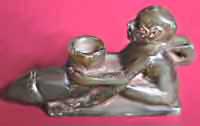
“The
tip of the penis is Yod,
the penis shaft itself is Vav and the
ten toes on my two feet are the two Heys; this is the
third general HAVAYA (Havaya).”
[Figure
2
Offering phallus]
Min:
Lettuce was thought to be the favorite food of the
fertility god, Min. He was depicted as a god with an erect penis, wearing a
feathered crown and carrying a flail. Lettuce was his sacred plant, and an
aphrodisiac to the ancient Egyptians - this particular species of lettuce was
tall, straight and secreted a milky substance when pressed.
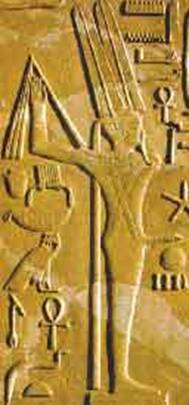
Another aphrodisiac was the onion. They were forbidden to
the priests who had vowed celibacy, for fear that their passion might take over,
and that they might desecrate themselves!
Fennel, ginger, pomegranates, coriander in wine and
radishes mixed with honey were thought to have aphrodisiac qualities, too.[4]
 The Circle, bluntly, in Circle in the
Square represents the female, the rounded shape or 'hole' of her reproductive
organs, while the Square means the line of the penis. The Circle
is within the Square, that is symbolically and effectively ruled by the male,
even where metaphysically (for instance in the medieval cosmogony where the
encircling ether or sky is female, while the encircled fountain represented by
the Hebrew letter yod is male), or materially (during coitus, or while
pregnant) she seems to surround and contain the male; for her purpose for being
is in nourishing and setting off the glory and power, and to serve, and
ultimately, "when she is good", to become the crown of the male
organ or as Wolfson explains, the woman's highest pride would be to inhabit
the very corona of the circumcised penis! [5] Hummm…………………….
The Circle, bluntly, in Circle in the
Square represents the female, the rounded shape or 'hole' of her reproductive
organs, while the Square means the line of the penis. The Circle
is within the Square, that is symbolically and effectively ruled by the male,
even where metaphysically (for instance in the medieval cosmogony where the
encircling ether or sky is female, while the encircled fountain represented by
the Hebrew letter yod is male), or materially (during coitus, or while
pregnant) she seems to surround and contain the male; for her purpose for being
is in nourishing and setting off the glory and power, and to serve, and
ultimately, "when she is good", to become the crown of the male
organ or as Wolfson explains, the woman's highest pride would be to inhabit
the very corona of the circumcised penis! [5] Hummm…………………….

SUN
and SUN SIGN: The sun was worshipped as a personified, life-giving deity in
Babylonian, Egyptian, Greek, Roman, and other major civilizations of history.
The more common symbol is the familiar face in the center of the sun's rays. A
dot or point in the center of a circle symbolizes the blending of male and
female forces. (See air, which also represents spirit, among the symbols for
Elements) Hindus call the midpoint in a circle the Bindu - the spark of
(masculine) life within the cosmic womb.[6]
Two of these [kabeiric] vases depict Odysseus and a Negro
Circe... Snowden, p. 161.
Note: Circe - is where we get the English word circle
and church! http://watch.pair.com/symbol.html
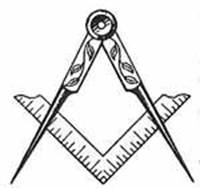
COMPASS (Masonic): The Masonic symbol of the compass and the
T-square represents movement toward perfection and a balance between the
spiritual and physical which resembles Egyptian and oriental mysticism. The
compass (used to form circles) represents spirit. The ruler (part of a square)
represent the physical. Some public schools pass out pencil cases and other
gifts decorated with this emblem.[7]
What of Circumcision
and it’s meaning outside of the covenant?
“From Herodotus we are
informed the Syrians learned circumcision from the Egyptians, as did the
Hebrews. Says Dr. Inman:
"I
do not know any thing which illustrates the difference between ancient and
modern times more than the frequency with which circumcision is spoken of in the
sacred books, and the carefulness with which the subject is avoided now. To
speak of any man as being worthy or contemptible, as men and women did among the
Jews, according to the condition of an organ never named, and very rarely
alluded to, in a mixed company of males and females among ourselves, shows us
that persons holding such ideas must have thought far more of these matters, and
spoken of them more freely, than we have been taught to do. Abundance of
offspring is the absorbing promise to the faithful; a promise liable to fail
except the parts destined to that purpose were in an appropriate
condition."
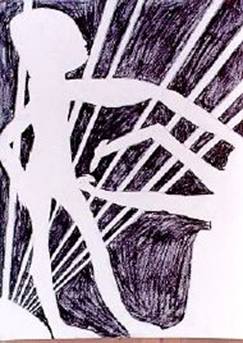
So, the Kabalistic rendering of the
Yod Y is
the head or corona or penis of Yahweh, the circle or the circumcised penis is
the corona and the highest pride to have encircled as a woman. [Well, that may
be a masculine fantasy] and Circe was
the name of an African man! What does all this mean? Sounds like a brother’s
penis somewhere hiding in the English and church lexicon, could it be Osiris who
lived in On or
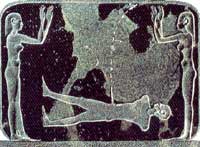
The
sperm of Osiris
We see that Jacob who obviously
understood the allusion to ‘Son of my right [hand] testicle”, also
understood the power of Ben-Oni’s name. But remember we are reading the sanitized
version of the translation of the Bible.
That is why the translators did not
say ‘Son of my right testicle, they said ‘Son of my right hand’ or ‘Son
of the south’ [below the belt], which was another way of saying Man or Male
Issue, because they believed a male descended from the right
testicle. The Anu meant men [and women] and from the above picture they did
not mind showing you their strength in pictorial form, which was an erect penis.
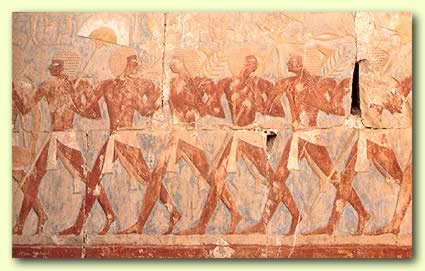
Soldiers
with penis out
The first men and all who were of
promise were named after them as in the case of the Biblical Ben-Oni.
Joseph’s baby brother. Joseph after being brought to
The name Anu was well know thought
African and its’ relatives in different nations.
Let me begin with Dr. Diop’s quote from Maspero:
“Loudim,
the eldest among them, personifies the Egyptian proper, the Rotou or Romitou of
the hieroglyphic inscription. Amamim represents the great tribe of Anu, who
founded On of the north [
Here is a peusdo-hieroglyphic
inscription of my name: Ekowa Kenyatta, the symbol in the case of Anu related
towns and people would always have 3 pillars, as my name has 2 feathers.
So every one would know by the ‘calling card’ or standing stones that
these people, towns, nations were associated with the Anu.
![]()
![]()
![]()
![]()
![]()
![]()
![]()
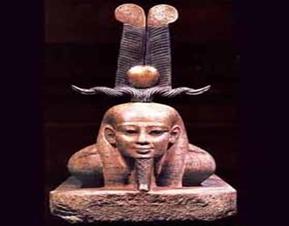
Feathered [tablet] Crown with cow horns
Then Diop counters on Maspero Thesis:
“Another
contradiction; Maspero seems at times to accept the theory of Asiatic origin of
Egyptians and recalls Pliny the Elder, who attributed the founding of
What interested me are the connection with the tribe Anu
and the Biblical On and
Diop quotes another scholar Amélineau:
‘From
various legends, I have been able to conclude that the population settled in the
Nile Valley were Negroes, since the goddess Isis was said to have been a reddish
–Black woman. In other words, I have explained, her complexion of café au
lait [coffee with milk], the same as that of certain other Blacks whose skin
seemed to cast a metallic reflection of copper.
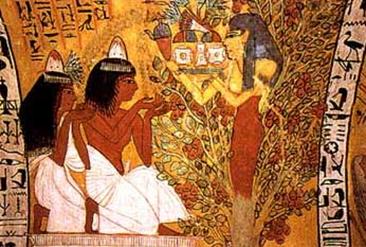
Hebrew definition of the Adam created
in the Biblical account is: Red, ruddy, black, soil, land.
“And he made Adam out of the dust [dirt] of the ground.”
He continues:
“Amélineau designated the first black race to occupy
“’All those cities have the characteristic [Hieroglyphic] symbol
that serves to denote the name Anu.” Pg. 76’”
Question:
What was the characteristic symbol or
mark that made men know those towns were settled or founded by the Anu?
Diop from Great African
Thinkers;
“…we have one
portrait of a chief, Tera Neter, roughly modeled in relief in green glazed
faience, found in the early temple at
So, does
You can easily call it Zi-Anu:
(z
![]() ´
´
![]() n) (KEY)
n) (KEY)
![]() ´
´
![]() n) (KEY),
section of
n) (KEY),
section of
Tutmoses III and King David
Tutmoses III fought the Assyrians [Syrians]:
“He [Tutmoses III]
extended Egyptian territory and power considerably, into Mesopotamia, Canaan [
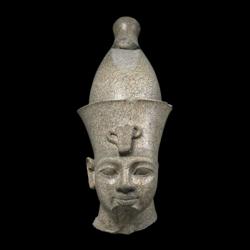
TutMoses
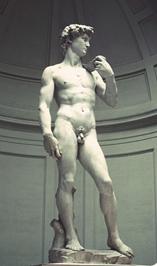
Euro
David
Tutmoses III exploits above are identical to the Biblical
David’s. There is a connection between the Cities of Egypt and
·
It was at this time
that Tutmose III "established
garrisons in
·
Tutmose III was able to cross the
·
Tutmose III (David) "recovered his border at the river
The military similarities between them two rulers can not
be ignored. If David was Tutmoses then he connects the City of
Diop quotes:
“Among the monumental narratives engraved on the walls
of Egyptian temples and referring to the great insurrections in
If
The Tel Dan
Stele
The new discovery was a piece of an inscribed monument or "stele."
It was found by accident; as such things usually are, at an archaeological dig
in the ruin ("tel") of the ancient city of
The fragment measured 32 by 22 cm. at its widest point. It was broken on
all sides except the right margin, so the size of the original monument could
not be determined. It was made of basalt, which was a very expensive stone in
antiquity. Since it would have been costly to produce, the monument could not
have been erected by just anybody. It was most likely the work of a king (Fig.
2).
There were thirteen lines of
writing preserved on the fragment in an early form of the alphabet. The letters
were clear and elegantly inscribed. The language was instantly recognized as
Aramaic, the mother tongue of ancient
Remember the surest DWD
it will be important for connecting the dots with the name David with the name
Tutmoses.
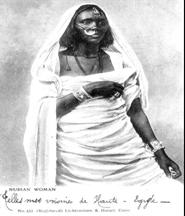 On
the death of Queen Hapshepsut, the great reign of the Eighteenth-Dynasty began
under Tutmoses III, that other outstanding southern monarch, whose mother was a
Sudanese Nubian.
On
the death of Queen Hapshepsut, the great reign of the Eighteenth-Dynasty began
under Tutmoses III, that other outstanding southern monarch, whose mother was a
Sudanese Nubian.
Figure
3
-A Sudanese Nubian
woman
Possibly
the ancestor of Tutmoses III
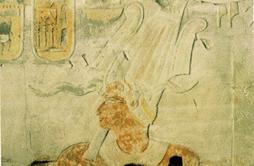
Relief
of TutMoses III
Elephantine
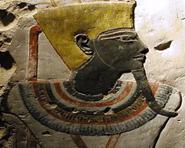
Tutmoses
III at Del Bahari
“On this painted
temple relief, Tuthmoses III wears the atef-crown, which elaborately
combines a tall central element resembling the White Crown with two ostrich
plumes; the long, curling horns of a ram; sun disk; and uraeus. In back is a
falcon with outstretched wings. The falcon was a favorite motif of Tuthmosis III
and is often associated with his image. At the upper right are the two
cartouches identifying the ruler by his throne name, Menkheperra, and birth
name.”
The Obelisk moved [stolen] to Central
Park in
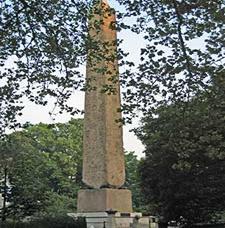
Figure 4
Who was the Biblical David?
His name means ‘Beloved’ and he
was the 8th son of Jessie. There
is no Biblical record of the name of David’s mother, but it is obvious they
want that hidden because David was treated like an outcast in the biblical
account. He was not counted as a Son
to Jesse when the prophet Samuel cam looking to anoint him David King. He was a
descendant of Ruth the Moabitess and he was probably a Pharaoh.
“Biblical
minimalists hold that David and his
The
details of David's life given in these articles come from the Hebrew Bibles and
are not corroborated by other historical documents. However, an ancient
inscription found at Tel Dan is generally considered to refer to a king of the
"House of David", providing indirect evidence that David did
exist as a historical king.”[9]
According to the Talmud (Bava
Basra 91a) David’s mother was: Nizbet bas Adael where they got the name is unknown as well as the
meaning of her name. Although, there is not other reference to that or any other
name in history. David was considered in the Bible as a bastard or born out of
wedlock and his father Jesse was ashamed of him.
Well, Ok enough
of the Talmud. So, I tried to break down the name in Hebrew.
Niz or Nes:
The
Hebrew word nes is defined in the Even Shoshan dictionary as follows:
1) A banner, standard
or identifying sign of a unit
2) A miraculous event,
something supernatural.
3) An island, dry land
surrounded by sea (from Greek nesos). A sign or remembrance.
Bet: is a house
or the number two.
Bas: means Daughter of.
El: God or
mighty one as in Elohim, used in ancient times at the ending of names to say
what god you served as in Dani’el.
David’s mother name may have meant:
·
Niz [Nes]bet – The miracle
or banner for the Great House.
·
Ada’El – The Ornament of
God
The House of Egypt is called the
‘Great House’ or Pharaoh. Ahmed Osman says when Joseph cried the ‘House of
Pharaoh’ heard, and that is another name for the Wife of Pharaoh.
Together her name means: The sign
or the Great House, the daughter of the ornament of El.
Who could that possibly have been?
Let us look to an
Tutmoses III mother was said to have
been a concubine of Tutmoses II said to be Auset or Isis. This may have been
another Isis and not the original Isis who was married to Osiris and
birthed Horus.
What
is the Kings concubine mean? Concubine is a minor wife or second wife.
‘Pharaohs also had
a host of 'minor wives' but, since succession did not automatically pass
to the eldest son, such women are known to have plotted to assassinate their
royal husbands and put their sons on the throne. Given their ability to directly
affect the succession, the term 'minor
wife' seems infinitely preferable to the archaic term 'concubine'.
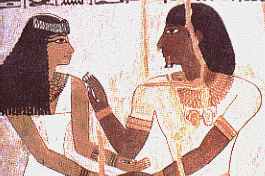
Yet even the word
'wife' can be problematic, since there is no evidence for any kind of legal or
religious marriage ceremony in ancient
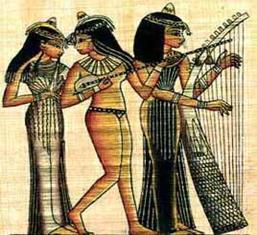
There is no
unambiguous evidence of a man having more than one wife at a time, although
there is some evidence of men who fathered children by a servant girl when their
wives were unable to conceive.[10]
But check this OUT!!!
Remember the name of David’s mother according to the Talmud? Nizbet bas
Adael meant:
The sign or the Great House, the
daughter of the Ornament of El.
‘Such women were given
the title 'ornament of the king', chosen for their grace and beauty to
entertain with singing and dancing. But, far from being closeted away for the
king's private amusement, such women were important members of court and took an
active part in royal functions, state events and religious ceremonies.’ [11]
Isis or Auset means: Throne or seat of authority.
The titles Ornament of the
King (Xkrt nsw) and Sole Ornament of the King (Xkrt nsw watt) were
equivalent to the modern expression, Lady in Waiting.
Now that
is interesting! Her name is an honor or miracle a sign for the house that is an ornament
for a mighty man or God in the Hebrew sense and in the Egyptian he was an
ornament of the Pharaoh.
Remember
David is the one who was related to Ruth the Moabitess and the foundation on
which the Messiah was to come forth. But, why then would his father not count
him among those who were to be examined by Samuel?
“Then Jesse called
Abinadab and made him pass before Samuel. And he said, "The LORD has not
chosen this one either." Next Jesse made Shammah pass by. And he said,
"The LORD has not chosen this one either." Thus Jesse made seven of
his sons pass before Samuel. But Samuel said to Jesse, "The LORD has not
chosen these." And Samuel said to Jesse, "Are these all the
children?" And he said, "There remains yet the youngest, and behold,
he is tending the sheep." Then Samuel said to Jesse, "Send and bring
him; for we will not sit down until he comes here." 1 Sam. 16:8-11
KJV.
David was
not counted in with Jesse 7 sons and they did not sit down? Why? Was this an
allusion to his royalty?
"And
Jesse made seven of his sons pass before Samuel. And Samuel said to Jesse,
"The Lord has not chosen these." And Samuel said to Jesse, "Are
all your sons here?" And he said, "There remains yet the youngest,
but behold, he is keeping the sheep." And Samuel said to Jesse, "Send
and fetch him; for we will not sit down till he comes here." And he sent,
and brought him in. Now he was ruddy, and had beautiful eyes, and was
handsome. And The Lord said, "Arise, anoint him; for this is he." Then
Samuel took the horn of oil, and anointed him in the midst of his brothers; and
the Spirit of The Lord came mightily upon David from that day forward." (1
Samuel 16:10-13 RSV)
King Saul
referred to David this way:
The transition of the
monarchy from Saul to David did not occur immediately, or easily. Saul was
killed in battle against the Philistines before David became king of all
This was
probably a dig at his spurious birth. Here David is repenting and confessing to
God in Psalms 51, mentions his birth it is obvious that David and
others considered him a bastard [fatherless] child of Jesse.
“Behold, I was brought
forth in iniquity, And in sin my mother conceived me.”
Did that bastard title relate to
Tutmoses III?
Thutmose II's first wife Hatshepsut considered Thutmose III
as a bastard lacking of royal blood in his veins. Thutmose III spent his
youth in
This made a link between political and religious world.
Educating a future pharaoh was a very good guarantee for the priests to increase
their power in
Thutmose was about 30 years old when he, at last, took
the Egyptian throne.”
|
Tutmoses |
David |
|
Born of Thoth [wisdom] The highest form of Love. |
Beloved. A man after God’s own heart. |
|
Men-Kheper-re –Lasting is the Sun [manifestation of Re. |
Elhanan –Whom god El] helped or graciously bestowed help. |
|
Djehutymes: The Mighty Prince |
You shalt feed my people |
Note:
The Royal blood was descendant from
the Ethiopian woman historically.
David was anointed at an early age as prince and King and then summoned to play his instrument for King Saul at the age of 17.
According to the Catholic
Encyclopedia:
“By God's command, David,
who was now thirty years old, went up to
Thutmose was about 30 years old when he, at last, took
the Egyptian throne.”
The connection with David and
Tutmoses is too lengthy to go into, I will leave that to the student in you, but
suffice it to say, the similarities are striking!
If, David is Tutmoses III then that
is further proof that
Let’s look at Amos 1:2
“The Lord will roar from
It is a pity that our
translators had not followed the hemistich form of the Hebrew meaning:
Using
the hemistich from it would read:
“The
Lord from
Is it God from
DWD and TWT similarities exists. Now,
let me leave you with this.
“History
and Archeology al indicated that the David who created the empire inherited by
Solomon can have been only one person – his ancestor Tutmoses III…the
greatest king of the ancient world. (David is dwd
in the Bible, which, in transliteration into Egyptian becomes twt
the first part of the name of Tutmoses III) The empire that he went ‘to
recover’ had been established initially by hiss grandfather Tutmoses I…,who
had himself erected the stele by the
The
Dan Stele:
There were thirteen lines of writing preserved on the fragment in an
early form of the alphabet. The letters were clear and elegantly inscribed. The
language was instantly recognized as Aramaic, the mother tongue of ancient
We see the connection with
To be continued…
Blessings,
Ekowa
2oo5-2oo6
Sources:
The
African origins of Civilization - Diop
Great
African Thinkers –Diop
King
James Version Bible
Webster’s
Dictionary
Encyclopedia
Britannica
Strong’s
Concordance
Stranger
in the
House
of Messiah – Osman
Jesus
in the House of the Pharaoh’s -Osman
http://www.sacred-texts.com/sex/asw/asw01.htm
www.christianessays.freeservers.com/pyra.htm
http://www.clevelandart.org/archive/pharaoh/photos/photo08.html
http://www.homestead.com/wysinger/tuthmosisIII.html
http://www.nationmaster.com/encyclopedia/King-David
http://www.godrules.net/library/clarke/clarkeamo1.htm
http://www.keyway.ca/htm2002/20021222.htm
http://www.bbc.co.uk/history/ancient/egyptians/women_04.shtml
[5] Circle in the Square: Studies in the Use of Gender in Kabbalistic Symbolism Elliot R. Wolfson, (Albany: SUNY P, 1995). 268 p.
[7] Ibid
[8] http://72.14.253.104/search?q=cache:adMOrcdsUVYJ:www.nytimes.com/books/first/m/
mckenzie-david.html+King+David+and+Megiddo&hl=en&gl=us&ct=clnk&cd=9
[9] Encyclopedia Britannica 1993
[11]
BBC
documentary on Pharonic
[12] Pg, 97 Jesus and the House the Pharaohs, Ahmed Osman